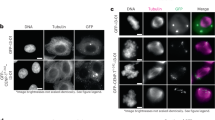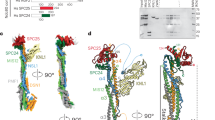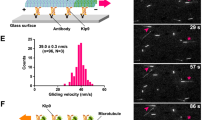Abstract
Kinetochore attachment to spindle microtubule plus-ends is necessary for accurate chromosome segregation during cell division in all eukaryotes. The centromeric DNA of each chromosome is linked to microtubule plus-ends by eight structural-protein complexes1,2,3,4,5,6,7,8,9. Knowing the copy number of each of these complexes at one kinetochore–microtubule attachment site is necessary to understand the molecular architecture of the complex, and to elucidate the mechanisms underlying kinetochore function. We have counted, with molecular accuracy, the number of structural protein complexes in a single kinetochore–microtubule attachment using quantitative fluorescence microscopy of GFP-tagged kinetochore proteins in the budding yeast Saccharomyces cerevisiae. We find that relative to the two Cse4p molecules in the centromeric histone1, the copy number ranges from one or two for inner kinetochore proteins such as Mif2p2, to 16 for the DAM–DASH complex8,9 at the kinetochore–microtubule interface. These counts allow us to visualize the overall arrangement of a kinetochore–microtubule attachment. As most of the budding yeast kinetochore proteins have homologues in higher eukaryotes, including humans, this molecular arrangement is likely to be replicated in more complex kinetochores that have multiple microtubule attachments.
This is a preview of subscription content, access via your institution
Access options
Subscribe to this journal
Receive 12 print issues and online access
$209.00 per year
only $17.42 per issue
Buy this article
- Purchase on Springer Link
- Instant access to full article PDF
Prices may be subject to local taxes which are calculated during checkout




Similar content being viewed by others
References
Meluh, P. B., Yang, P., Glowczewski, L., Koshland, D. & Smith, M. M. Cse4p is a component of the core centromere of Saccharomyces cerevisiae. Cell 94, 607–613 (1998).
Meluh, P. B. & Koshland, D. Evidence that the MIF2 gene of Saccharomyces cerevisiae encodes a centromere protein with homology to the mammalian centromere protein CENP-C. Mol. Biol. Cell 6, 793–807 (1995).
Espelin, C. W., Kaplan, K. B. & Sorger, P. K. Probing the architecture of a simple kinetochore using DNA–protein crosslinking. J. Cell Biol. 139, 1383–1396 (1997).
Ortiz, J., Stemmann, O., Rank, S. & Lechner, J. A putative protein complex consisting of Ctf19, Mcm21, and Okp1 represents a missing link in the budding yeast kinetochore. Genes Dev. 13, 1140–1155 (1999).
Nekrasov, V. S., Smith, M. A., Peak-Chew, S. & Kilmartin, J. V. Interactions between centromere complexes in Saccharomyces cerevisiae. Mol. Biol. Cell 14, 4931–4946 (2003).
Euskirchen, G. M. Nnf1p, Dsn1p, Mtw1p, and Nsl1p: a new group of proteins important for chromosome segregation in Saccharomyces cerevisiae. Eukaryot. Cell 1, 229–240 (2002).
Wei, R. R., Sorger, P. K. & Harrison, S. C. Molecular organization of the Ndc80 complex, an essential kinetochore component. Proc. Natl Acad. Sci. USA 102, 5363–5367 (2005).
Westermann, S. et al. The Dam1 kinetochore ring complex moves processively on depolymerizing microtubule ends. Nature 440, 565–569 (2006).
Miranda, J. J., De Wulf, P., Sorger, P. K. & Harrison, S. C. The yeast DASH complex forms closed rings on microtubules. Nature Struct. Mol. Biol. 12, 138–143 (2005).
Chan, G. K., Liu, S. T. & Yen, T. J. Kinetochore structure and function. Trends Cell Biol. 15, 589–598 (2005).
McAinsh, A. D., Tytell, J. D. & Sorger, P. K. Structure, function, and regulation of budding yeast kinetochores. Annu. Rev. Cell Dev. Biol. 19, 519–539 (2003).
Pearson, C. G., Maddox, P. S., Salmon, E. D. & Bloom, K. Budding yeast chromosome structure and dynamics during mitosis. J. Cell Biol. 152, 1255–1266 (2001).
Collins, K. A., Furuyama, S. & Biggins, S. Proteolysis contributes to the exclusive centromere localization of the yeast Cse4/CENP-A histone H3 variant. Curr. Biol. 14, 1968–1972 (2004).
De Wulf, P., McAinsh, A. D. & Sorger, P. K. Hierarchical assembly of the budding yeast kinetochore from multiple subcomplexes. Genes Dev. 17, 2902–2921 (2003).
DeLuca, J. G. et al. Hec1 and nuf2 are core components of the kinetochore outer plate essential for organizing microtubule attachment sites. Mol. Biol. Cell 16, 519–531 (2005).
Wu, J. Q. & Pollard, T. D. Counting cytokinesis proteins globally and locally in fission yeast. Science 310, 310–314 (2005).
Pearson, C. G. et al. Stable kinetochore–microtubule attachment constrains centromere positioning in metaphase. Curr. Biol. 14, 1962–1967 (2004).
Nishihashi, A. et al. CENP-I is essential for centromere function in vertebrate cells. Dev. Cell 2, 463–476 (2002).
Hori, T., Haraguchi, T., Hiraoka, Y., Kimura, H. & Fukagawa, T. Dynamic behavior of Nuf2–Hec1 complex that localizes to the centrosome and centromere and is essential for mitotic progression in vertebrate cells. J. Cell Sci. 116, 3347–3362 (2003).
Yang, S. S., Yeh, E., Salmon, E. D. & Bloom, K. Identification of a mid-anaphase checkpoint in budding yeast. J. Cell Biol. 136, 345–354 (1997).
Ciferri, C. et al. Architecture of the human ndc80–hec1 complex, a critical constituent of the outer kinetochore. J. Biol. Chem. 280, 29088–29095 (2005).
Russell, I. D., Grancell, A. S. & Sorger, P. K. The unstable F-box protein p58–Ctf13 forms the structural core of the CBF3 kinetochore complex. J. Cell Biol. 145, 933–950 (1999).
Espelin, C. W., Simons, K. T., Harrison, S. C. & Sorger, P. K. Binding of the essential Saccharomyces cerevisiae kinetochore protein Ndc10p to CDEII. Mol. Biol. Cell 14, 4557–4568 (2003).
Chen, Y. et al. The N terminus of the centromere H3-like protein Cse4p performs an essential function distinct from that of the histone fold domain. Mol. Cell Biol. 20, 7037–7048 (2000).
Shang, C. et al. Kinetochore protein interactions and their regulation by the Aurora kinase Ipl1p. Mol. Biol. Cell 14, 3342–3355 (2003).
Uetz, P. et al. A comprehensive analysis of protein–protein interactions in Saccharomyces cerevisiae. Nature 403, 623–627 (2000).
Maddox, P. S., Bloom, K. S. & Salmon, E. D. The polarity and dynamics of microtubule assembly in the budding yeast Saccharomyces cerevisiae. Nature Cell Biol. 2, 36–41 (2000).
Zinkowski, R. P., Meyne, J. & Brinkley, B. R. The centromere–kinetochore complex: a repeat subunit model. J. Cell Biol. 113, 1091–1110 (1991).
Longtine, M. S. et al. Additional modules for versatile and economical PCR-based gene deletion and modification in Saccharomyces cerevisiae. Yeast 14, 953–961 (1998).
Roumanie, O. et al. Rho GTPase regulation of exocytosis in yeast is independent of GTP hydrolysis and polarization of the exocyst complex. J. Cell Biol. 170, 583–594 (2005).
Acknowledgements
We thank A. Hunt, D. Odde, S. Inoué, and members of the Salmon and Bloom laboratory for helpful comments on the manuscript. This work was supported by National Institutes of Health (NIH) grants to K.S.B. (GM32238), and to E.D.S. (GM24364 and GM60678).
Author information
Authors and Affiliations
Corresponding author
Ethics declarations
Competing interests
The authors declare no competing financial interests.
Supplementary information
Supplementary Information
Supplementary Notes, Tables S1, S2, S3 and S4, Figures S1, S2, S3, S4, S5 and S6 (PDF 429 kb)
Rights and permissions
About this article
Cite this article
Joglekar, A., Bouck, D., Molk, J. et al. Molecular architecture of a kinetochore–microtubule attachment site. Nat Cell Biol 8, 581–585 (2006). https://doi.org/10.1038/ncb1414
Received:
Accepted:
Published:
Issue Date:
DOI: https://doi.org/10.1038/ncb1414
This article is cited by
-
Dicentric chromosomes are resolved through breakage and repair at their centromeres
Chromosoma (2024)
-
Multivalency ensures persistence of a +TIP body at specialized microtubule ends
Nature Cell Biology (2023)
-
Principles and dynamics of spindle assembly checkpoint signalling
Nature Reviews Molecular Cell Biology (2023)
-
The molecular basis of monopolin recruitment to the kinetochore
Chromosoma (2019)
-
High-resolution mapping of centromeric protein association using APEX-chromatin fibers
Epigenetics & Chromatin (2018)



